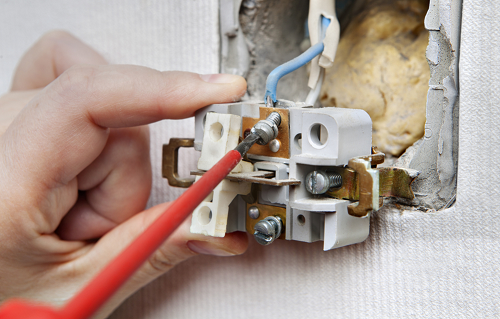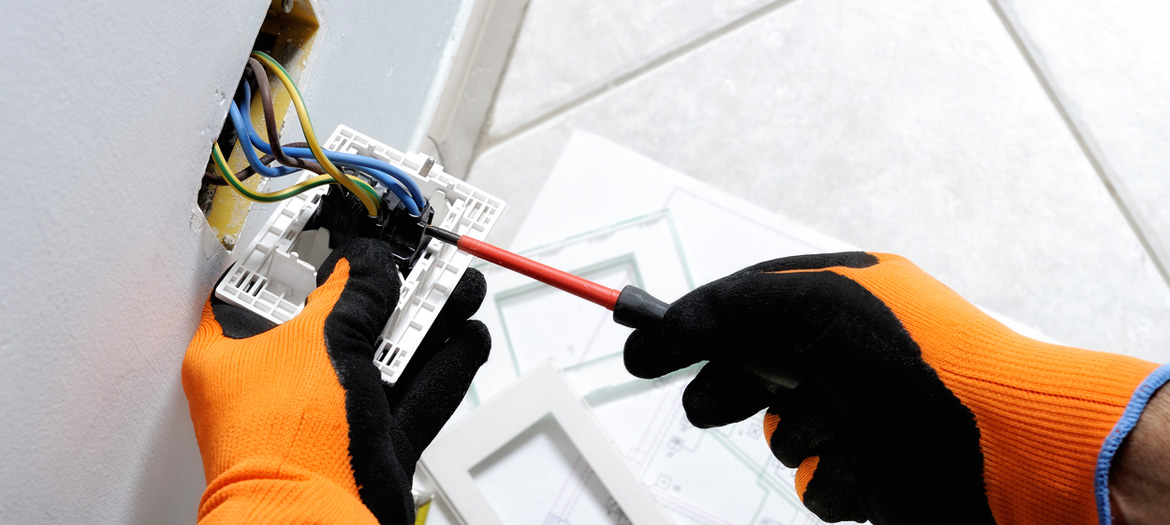Common Electrical Problems Every Home Owner Ought To Understand about
House owners typically come across numerous electrical problems that can affect security and capability. Problems like flickering lights and stumbled circuit breakers are a lot more common than numerous realize. These circumstances can indicate deeper electric concerns that warrant focus. Recognizing the indications and dangers connected with out-of-date electrical wiring and dead outlets is crucial. What procedures can be required to stop these issues? Discovering these common electrical issues might reveal vital insights for preserving a secure home environment.

Flickering Lights: Causes and Solutions
Why do some house owners experience flickering lights? Flickering lights can be a typical aggravation, usually indicating underlying electrical issues. One key cause is defective or loose links within lights or wiring, which can cause intermittent power supply. Furthermore, making use of high-wattage devices on the same circuit may cause voltage fluctuations, resulting in flickering or dimming. An additional potential concern is an overloaded circuit, where also numerous gadgets attract power at the same time, stressing the electrical system. Out-of-date or abject circuitry can add to inconsistent electric circulation. In many cases, flickering lights might signal a problem with the home's electrical panel or service line. Property owners must address flickering lights quickly to avoid possible risks. Solutions might consist of tightening connections, redistributing home appliance tons, or seeking advice from a qualified electrician for a detailed assessment. Recognizing the origin can aid ensure a secure and secure electrical system in the home.
Tripped Circuit Breakers: What You Need to Know
Have homeowners ever before wondered what triggers their circuit breakers to journey all of a sudden? This usual problem commonly occurs from an overload of electrical circuits, where a lot of devices draw power all at once. In such instances, the circuit breaker works as a security mechanism, interrupting the flow of power to avoid getting too hot and potential threats. An additional frequent reason is a short circuit, which happens when a live cable get in touches with a neutral cord, developing a surge of electrical power that journeys the breaker. Ground mistakes can likewise result in stumbled breakers; these happen when an online wire touches the ground or a based surface area, presenting serious safety and security dangers. Home owners should consistently evaluate their use of high-wattage devices to avoid overwhelming circuits. In addition, comprehending the feature of breaker can help them react appropriately during a journey, ensuring their home continues to be well-maintained and risk-free.
Obsolete Wiring: Signs and Risks
Out-of-date wiring can present considerable risks to home owners, frequently going unnoticed until troubles emerge. Houses developed prior to the 1980s may still have light weight aluminum electrical wiring or knob-and-tube systems, which are no longer taken into consideration safe. Indications of obsolete wiring include flickering lights, frequently tripped circuit breakers, or burning smells near electrical outlets. These signs may suggest that the electric system is overburdened or deteriorating.Additionally, home owners might notice swelter marks around buttons or outlets, which can suggest overheating. The threat of electric fires substantially raises with out-of-date wiring, as these systems were not designed to manage modern-day electric tons. House owners are motivated to have their circuitry evaluated regularly, specifically when refurbishing or adding new home appliances. By recognizing these indicators early, they can stay clear of unsafe scenarios and maintain a more secure living atmosphere. Upgrading to existing electrical criteria is a proactive step in keeping home security and efficiency.
Regularly Blown Fuses: Fixing Tips
Frequent blown fuses can indicate underlying electric concerns that might come from outdated wiring or overloaded circuits. Homeowners experiencing this trouble must first recognize the home appliances attached to the affected circuit. It is suggested to prevent using several high-wattage tools at the same time, as this can bring about circuit overload. If the issue persists, checking the fuse box for indications of wear or damages is critical; a damaged fuse box may call for replacement.Additionally, inspecting for loose connections within the circuit can assist prevent future incidents. Home owners must additionally verify that the integrates being made use of are of the correct amperage, as utilizing an inaccurate fuse can intensify the trouble. If these troubleshooting ideas do not resolve the problem, consulting an accredited electrical expert is recommended to review the electrical system additionally. Resolving these concerns quickly can help minimize dangers and guarantee the safety of the home's electric facilities.
Dead Outlets: Common Reasons and Fixes
When a home owner experiences a dead outlet, it can often give irritation and complication. A number of common causes might lead to this issue. One frequent offender is a stumbled circuit breaker, which can be quickly reset. If any kind of breakers are in the off setting, homeowners ought to examine their electric panel to check. An additional opportunity is a faulty outlet itself, which might require substitute. Additionally, loosened circuitry connections within the outlet can interrupt power flow, making assessment essential.Sometimes, the trouble may come from an overloaded circuit, particularly when multiple tools are linked. In such situations, redistributing the electrical tons can solve the concern. Property owners ought to additionally consider the age of their wiring; older systems might call for updates to satisfy modern electric demands. If these actions do not rectify the situation, consulting a licensed electrical contractor is recommended to ensure safety and correct diagnosis.
Electric Shocks: When to Be Concerned
Just how can property owners determine whether an electric shock warrants concern? House owners must initially examine the seriousness and context of the shock. A light static shock, commonly felt when touching metal objects, is usual and normally harmless. Nonetheless, if the shock happens while communicating with a plugged-in appliance or outlet, it might indicate a more significant issue.The location and regularity of the shocks are vital. Repeated shocks from the very same source, particularly in damp areas like restrooms or kitchens, might signal faulty wiring or inadequate grounding. Homeowners ought to also take into consideration the feeling of the shock; a jolt that triggers discomfort or muscular tissue tightenings is more alarming than a mere tingle.If there's any kind of uncertainty, it is suggested to speak with a qualified electrical expert. Ignoring potential electrical hazards can bring about significant safety dangers, including fire or serious injury.
Overloaded Circuits: Avoidance and Safety And Security Procedures
Overloaded circuits top article pose considerable dangers in residential settings, frequently leading to electric fires or devices damages (Level 2 Electrician). Property owners should recognize the indicators of an overloaded circuit, such as often stumbled breakers or dimming lights. Carrying out preventative safety and security techniques can assist minimize these dangers and assure a safer living atmosphere
Recognizing Overloaded Circuits
What indicators show that a circuit may be strained? Homeowners should be alert for several crucial indicators. Regularly stumbled breaker or blown integrates recommend excessive load on the circuit. Dimming or flickering lights, especially when various other home appliances remain in use, can signify an insufficient power supply. In addition, outlets or switches that really feel cozy to the touch may indicate getting too hot, a potential fire danger. Uncommon humming audios from outlets likewise necessitate attention, as they can signify electrical problems. If home appliances operate inefficiently or stop working to begin, it might be an indicator of an overloaded circuit. Recognizing these indications pop over to these guys early can assist prevent serious electrical problems and promote a much safer home environment.
Preventive Safety Practices
To maintain a efficient and safe electric system, homeowners should execute preventive security methods that attend to prospective circuit overloads. One efficient step is to avoid connecting way too many gadgets to a single electrical outlet, as this can surpass the circuit's ability. Utilizing power strips with built-in breaker can aid disperse power safely. Homeowners need to also frequently check cords and home appliances for damage and replace any kind of malfunctioning devices promptly. It is crucial to assure that breaker are functioning properly and to be mindful of the overall power level being used in each circuit. In addition, consulting a licensed electrical contractor for routine examinations can recognize prospective concerns before they rise, ensuring a safer living setting and extending the life-span of electric systems.
Frequently Asked Inquiries
How Typically Should I Have My Electrical System Inspected?
Normal evaluations of electric systems are recommended every 3 to five years. Home owners ought to take into consideration much more regular checks if they experience issues, embark on renovations, or reside in older buildings to ensure safety and security and conformity.
Can I Repair Electric Issues Myself or Employ a Professional?

What Are the Signs of an Electric Fire Danger?
Indicators of an electrical fire danger consist of frequently stumbled breaker, flickering lights, burning odors, blemished electrical outlets, or cozy, humming wires. House owners need to continue to be cautious and look for professional aid if any of these indicators exist.
Just how Do I Know if My Home Demands an Electrical Upgrade?
To establish if a home needs an electric upgrade, signs include constant breaker trips, out-of-date circuitry, insufficient outlets, flickering lights, and the visibility of older electrical panels, showing potential safety dangers and inadequacy.
Are There Particular Safety And Security Tips for Do It Yourself Electrical Work?
When considering do it yourself electric job, one should constantly transform off power, make use of insulated tools, verify circuit functionality, comply with regional codes, and consult professionals for intricate tasks to assure security and protect against crashes. Another possible issue is an overloaded circuit, where as well several gadgets draw power all at once, stressing the electric system. The risk of electrical fires noticeably increases with obsolete circuitry, as these systems were not designed to take care of contemporary electric tons. Regular blown integrates can suggest underlying electric concerns that might stem from out-of-date wiring or overloaded circuits. To preserve a effective and safe electrical system, homeowners should execute preventative safety and security practices that deal with possible circuit overloads. Accredited Service Provider Level my company 2 Electrician. Indications of an electrical fire danger consist of frequently stumbled circuit breakers, flickering lights, melting odors, stained electrical outlets, or warm, humming cables
Comments on “DIY electrical inspection list by a Level 2 Electrician”